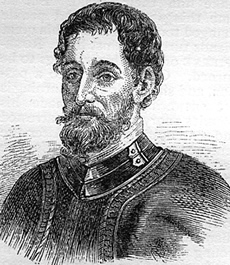 |
| Hernando De Soto - Spanish Explorer |
He left on February 25, 1514, for Castilla del Oro (present-day Costa Rica and Panama), where he served under Pedrarias Dávila. In 1524, he was involved with the conquest of Nicaragua. During this time, he and Hernán Ponce de León became partners and became two of the richest men in Nicaragua.
From 1524 to 1528, De Soto was involved with the exploration of the Pacific coast of South America financed by Francisco Pizarro, Diego de Almagro, and Hernando de Luque. It was in 1528 that the expedition made contact with the Incas.
When Pizarro launched his expedition into the Incan lands, he was in need of ships. De Soto and de León had a ship that Pizarro hired along with both men. The expedition set sail in December 1531. At that time, the Incan Empire was in the midst of a civil war and Pizarro used this to his advantage.
 |
Although his army was significantly smaller (a few hundred against hundreds of thousands), the Spanish army was technologically superior. Especially important to the Spanish were their mounted lancers led by De Soto, who repeatedly routed the Incan soldiers in battle.
Pizarro eventually captured the Incan emperor and after his ransom was paid, killed him. When the loot was divided up, De Soto came away with the third largest amount. Still, what De Soto really wanted was to govern his own territory in the New World, but Pizarro was not inclined to give him any territory to govern.
De Soto returned to Spain in 1536 with most of the gold and silver that he and de León had accumulated. De Soto used his new wealth to live well and get married. He was also admitted to the Order of Santiago. Charles V, the Holy Roman Emperor, granted De Soto the right to conquer Florida in 1537 and made him governor of Cuba. De Soto would have to pay for the expedition, but would receive land in the area as payment.
De Soto launched his expedition from Havana, Cuba, in May 1539, and landed on May 30 at Tampa Bay, where the expedition remained until mid-July. De Soto moved north, fighting battles with the local natives and looting their villages. He spent the winter of 1539–40 in the area of present-day Tallahassee.
On March 3, 1540, De Soto and his men started northeast passing through Georgia, South Carolina, and North Carolina. At that point De Soto turned west and his men became the first Europeans to cross the Appalachian Mountains. The expedition then moved through Georgia and Alabama, finally ending near Columbus, Mississippi. They stayed there through the winter of 1540–41.
The next year De Soto and his men continued west, and in June 1541 they became the first Europeans to see the Mississippi River, which they called the Río del Spirito Santo. They crossed the river on June 10 and continued west into Arkansas. De Soto’s scouts pushed farther west as far as the edge of the Great Plains.
The expedition spent the winter of 1541–42 camped in the area of modern-day Little Rock, Arkansas. It was during this winter that De Soto realized there was no great civilization in this area on par with the Incans or Aztecs, and that he was financially ruined. In spring he fell sick, and on May 21, 1542, he died. His body was dropped into the Mississippi River.
The remainder of the expedition explored eastern Texas before returning to the Mississippi River. From there they built barges and floated down the river to the Gulf of Mexico. Then they sailed along the coast until they finally reached a Spanish settlement in Mexico in September 1543.
With De Soto’s death, de León sought to recover money he said De Soto owed him. De Soto’s widow fought these charges in court, but the decision of the court was not recorded.
EmoticonEmoticon